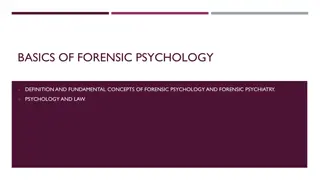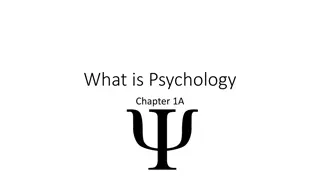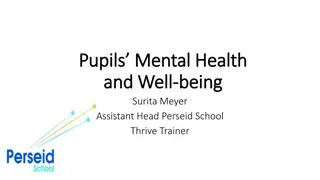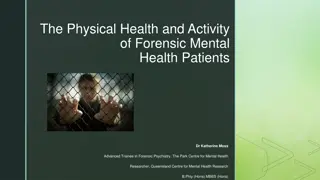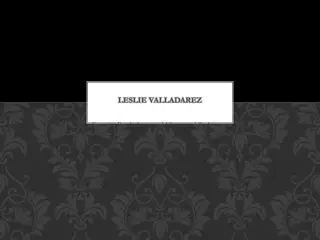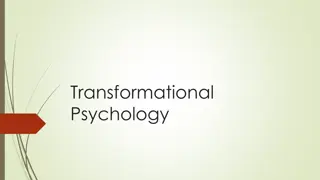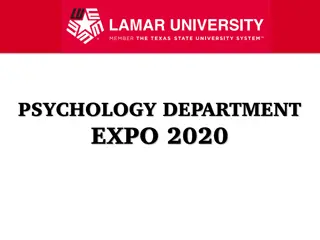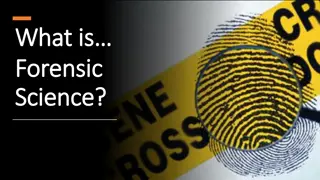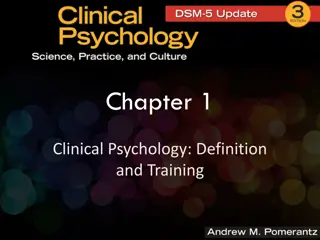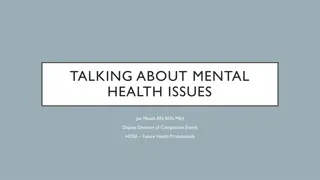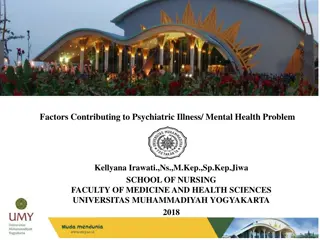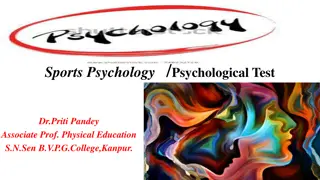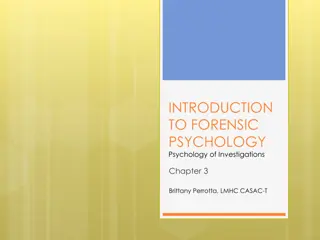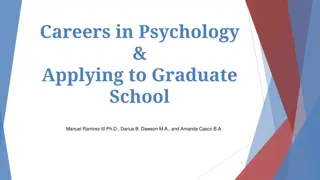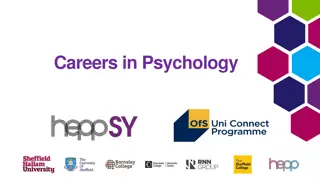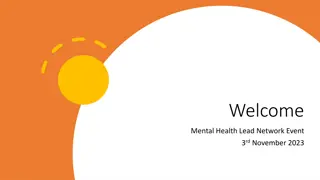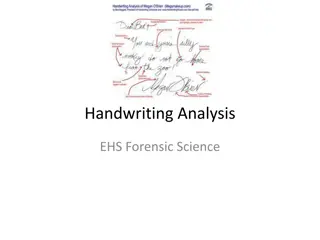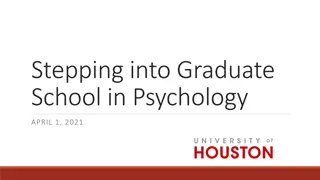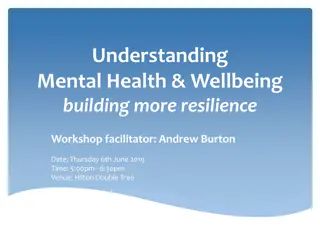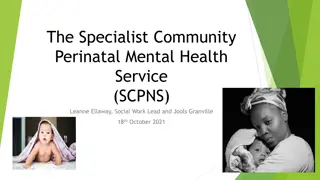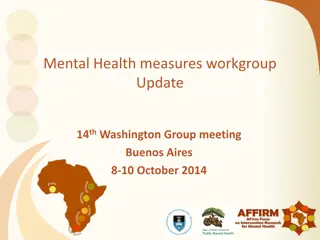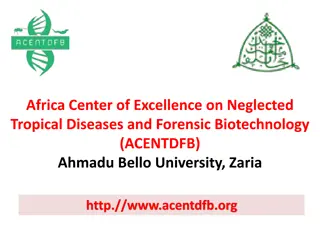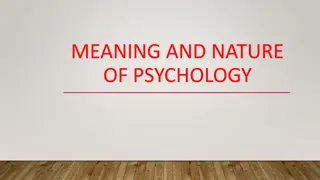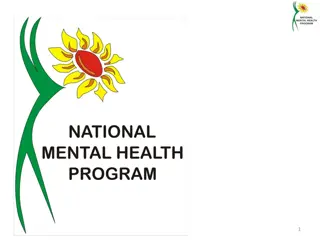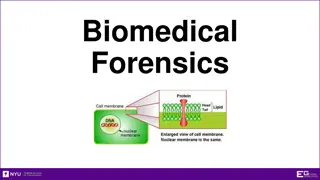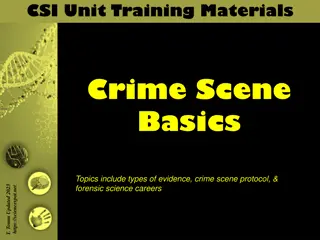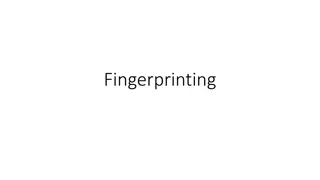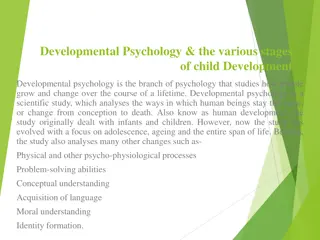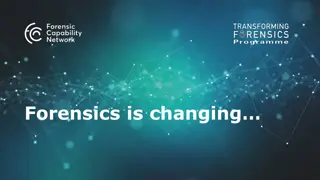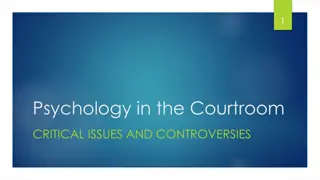Understanding Forensic Psychology and Risk Factors in Mental Health
Explore the intersection of psychology and law with a focus on forensic topics such as capacity, competency, civil commitment, treatment refusal, violence risk factors, suicide risk factors, exceptions to patient confidentiality, informed consent, and malpractice. Understand the complexities of addressing mental health issues within legal frameworks.
Download Presentation

Please find below an Image/Link to download the presentation.
The content on the website is provided AS IS for your information and personal use only. It may not be sold, licensed, or shared on other websites without obtaining consent from the author. Download presentation by click this link. If you encounter any issues during the download, it is possible that the publisher has removed the file from their server.
E N D
Presentation Transcript
Charles Camp, MS IV ctcamp@buffalo.edu Psych Review III
Topics Forensics Child and Adolescent Psych Defense Mechanisms Attachment Personality Disorders Autism Spectrum Disorders ADHD Psychotherapy
Forensics Capacity ability to make medical/treatment decisions Clinical term, determined by physician Competency ability to stand trial (work with lawyer, understand the process etc.) Legal term, determined by a judge Civil Commitment legal basis for involuntary hospitalization due to mental illness: Danger to themselves or others Not meeting their own basic needs Right to refuse treatment patients have this right, with some exceptions: Allowed to treat in emergencies (imminent risk of harm to themselves or others) Physician can pursue Treatment Over Objection (proceedings vary by state)
Forensics Violence Risk Factors: Prior history of violence most reliable risk factor Younger age (late teens, early 20 s) prefrontal cortex not fully developed Males (unless mental illness is present) Low SES, less education, low IQ Homelessness Employment instability Substance abuse Mental Illness psychosis/schizophrenia, depression, bipolar disorder, personality disorders (antisocial, borderline, paranoid) Specific symptoms paranoia, persecutory delusions, command auditory hallucinations, disorganized thinking and behavior, irritability, impulsivity
Forensics Suicide Risk Factors (SAD PERSONS): Sex male Age teenager or elderly Depression Previous attempt Ethanol or drug use Rational thinking loss Sickness (medical illness, taking 3 or more prescription medications) Organized plan No spouse (divorced/widowed, single, childless) Social support
Forensics Exceptions to patient confidentiality: Patient makes explicit threat (or physician infers it) duty to warn victims, notify law enforcement, arrange for voluntary/involuntary hospitalization (Tarasoffv. Regents) Suicidal or homicidal patient Informed Consent: Requires discussion of all pertinent information (facts about interventions, benefits, risks, alternatives (including no intervention)), patient agrees, and free from coercion Exceptions patient lacks capacity, emergencies, waived by patient 4 D s of Malpractice Dereliction of Duty Directly causing Damages: Duty to patient Dereliction physician breached that duty Damage patient suffered harm Direct the harm suffered was caused directly by the breach of duty
Child and Adolescent Psych Oppositional Defiant Disorder: Negative, hostile, defiant behavior Argues/opposes authority figures Temper tantrums Refuses to follow rules Blames others for own mistakes Gets along well with friends/peers Conduct Disorder: Violates basic rights of others Aggressive or violent towards people/animals Destroys property, arson Deceitfulness/theft Serious rule/law violation Age < 18 years 40% 30% ODD Antisocial Personality Disorder (100% had conduct disorder) Conduct Disorder Age 18 Tx behavioral intervention!, train parents, multisystemic therapy, medications for comorbid ADHD (methylphenidate, clonidine, guanfacine)
Child and Adolescent Psych Disruptive Mood Dysregulation Disorder Recurrent, disproportionate, severe temper tantrums (typically 3+ /week), can last hours Persistently irritable or angry for most of the day Tx behavioral interventions, medications Major Depressive Disorder Children (M = F): irritable, aggressive, disruptive, somatic complaints, poor self-esteem Adolescents (F > M): depressed mood (still element of irritability), social isolation, declining grades, hypersomnia, substance abuse, SI 20-40% go on to develop bipolar disorder within 5 years Tx psychotherapy, SSRI if necessary (be wary of transient increased suicidality ) Bipolar Disorder Mania irritability (almost never euphoric), sexual preoccupation, anger/aggression, hyperactivity (can look similar to ADHD), pressured speech, need little sleep Tx don t shy away from medications here (mood stabilizers, antipsychotics, antidepressants), therapy, hospitalization
Child and Adolescent Psych Separation Anxiety Disorder Excessive stress when separated form parents or home (beyond what is normal) School refusal, clinging, worried harm will come to parents Somatic symptoms common stomach aches, headaches Precursor to panic disorder in adults Tx psychosocial interventions (CBT, family therapy, play therapy) PTSD Age > 6 = need same 4 symptom clusters (intrusion, avoidance, cognition/mood, arousal/reactivity) as adults Age < 6 = need intrusion + arousal/reactivity + avoidance OR cognition/mood Re-enact trauma through play, often re-experience trauma while relaxed (vs. stressed in adults) Tx - psychotherapy, SSRI s, alpha agonists, atypical antipsychotics
Child and Adolescent Psych Tics sudden, rapid, recurrent, non-rhythmic, stereotypical movements or vocalizations (blinking, nodding, grunting, coprolalia) Tourette s Syndrome vocal AND motor tics that occur multiple times over 1 year Tx clonidine, guanfacine, atypical antipsychotics Schizophrenia Children 1stdegree relative, borderline intelligence, anxiety, hyperactivity, delayed speech/language, hallucinations (not delusions) Adolescents negative prodrome, apathy, poor hygiene, social withdrawal, declining grades, anxiety, SI Tx medications (antipsychotics) + therapy
Child and Adolescent Psych Abuse and neglect ALWAYS ask, MUST report suspicion to CPS Abuse physical/sexual/psychological Bruises, burns, behavior changes (acting out, detachment, nightmares) Neglect failed to properly care for the child Self-injurious behavior a symptom, not a diagnosis Intent is not suicidal more of a coping mechanism for emotional release Can be seen in depression, anxiety, PTSD, substance abuse Tx therapy, identify underlying diagnosis and treat accordingly
Defense Mechanisms 3 Stages of Becoming a Self Mimicry imitating another s behavior Introjection incorporating part of another but the source identity is retained Identification taking another s attitude/behavior and making it part of one s own identity Defense mechanisms = phenomenon that help us resolve intrapsychic conflict and anxiety/discomfort Largely unconscious Can be adaptive or maladaptive (rigid, distorts reality)
Maladaptive Defenses Repression involuntaryremoving of memories/thoughts/impulses from consciousness; cannot voluntarily recall Adult unable to recall prior history of child abuse despite having other memories from same time period Denial refusing to perceive unpleasant reality I don t have a mental illness. Displacement transferring emotions/ideas/wishes from original subject to a more acceptable substitute Resident frustrated with attending yells at medical student Reaction Formation behaving exactly opposite of one s true, unacceptable feelings/impulses Secretary hates boss bakes him cookies Projection attributing own unacceptable impulses/thoughts/desires to another I m not angry, YOU RE angry!!!! (person truly sees/experiences the anger from the other even though it isn t there)
Maladaptive Defenses Rationalization think up logical, socially acceptable explanations for unacceptable or intended behavior Man impulsively buys luxury car explains it is much more safe and reliable Intellectualization using scientific or abstract thinking to avoid painful realities Cancer patient explains to friend the pathophysiology of the disease Isolation separating emotional components from a thought resulting in repression of either Mother describes son s death without emotion Person mugged in an alley feels sudden panic when in alleyways without cognition of the memory Splitting perceiving one s self and others as all good or all bad rather than a combination of both Patient describes attending as worst ever and nursing staff as best ever Can apply to self, others, or objects/places
Adaptive Defenses Suppression voluntary(vs. repression) and deliberate effort to control/conceal disturbing thoughts/feelings; can voluntarily recall Husband has a stroke wife calls 9-11 and relays full history before bursting into tears Sublimation diverting basic drives/impulses into socially appropriate channels Frustrated teenager relieves anger through playing contact sports Humor seeing comic side of situations to diffuse anxiety/negative emotion Man embarrassed to dance at a party jokes about his lack of coordination Altruism taking a negative experience and turning it into a socially positive one (reaching beyond the benefit of the individual vs. sublimation) A former addict travels to schools to educate youth on the risks of drug use
Attachment Types When mom reenters the room during the Strange Situation : Secure child is quickly calmed and shortly thereafter returns to play Insecure-avoidant child appears depressed and does not engage mom Insecure-Ambivalent child has a mixed response; wants mother back but also expresses anger about her leaving Insecure-Disorganized child is very confused and doesn t know how to respond Insecure attachments likely caused by inconsistencies in the care of the mother for the child.
Personality Disorders Personality assemblage of traits (behavioral/emotional/cognitive) which characterize the self; stable, consistent Personality Type recognizable patterns of traits that tend to cluster together Personality Disorder particular personality patterns that are inflexible, pervasive, maladaptive, and impair function/cause distress 3 Personality Disorder Clusters: A odd, aloof, socially awkward, eccentric (weird) Associated with psychotic disorders B dramatic, intensely emotional, erratic, entitled (wild) Associated with mood disorders and substance use C anxious, fearful (worried) Associated with anxiety disorders
Cluster A Paranoid suspicious, consistently misinterprets other s actions as deliberately demeaning or threatening Schizoid detached, no interest in social relationships (fish bowl) Schizotypal social deficits, eccentric, magical thinking, ideas of reference Tend to have family hx of schizophrenia
Cluster B Histrionic excessively emotional, attention-seeking, dramatic Narcissistic grandiose, entitled, arrogant, lacks empathy Antisocial violates the basic rights of others, deceitful, manipulative, superficially charming, lacks empathy (age > 18) 100% will have had conduct disorder (age < 18) Borderline unstable and reactive affect, intense interpersonal relationships, impulsivity, splitting, feelings of emptiness
Cluster C Avoidant social inhibition, feeling inadequate, hypersensitive to rejection Desire for emotional closeness (vs. schizoid) Dependent excessive need to be taken care of, submissive, clingy, can t make decisions without excessive advice or reassurance Obsessive-Compulsive preoccupied with perfection, orderliness, and control No intrusive thoughts or compulsions, ego-syntonic (vs. OCD)
Autism Spectrum Disorders Autism Spectrum Disorder Impairment in reciprocal social communication (difficulty reading facial expressions, developing and maintaining relationships, interpreting non-verbal communication) Repetitive patterns of behavior, interests, or activities (stereotyped movements, adherence to routines, hyper/hypoactivity to sensory input) 4:1 M:F Genetic and environmental risks (advanced paternal age, low birth weight etc.) Co-morbidities sleep disorder, seizures, psych disorders Tx therapy (speech and language, special ed, social skills training), antipsychotics for irritability/frequent tantrums (risperidone, aripiprazole) Social Communication Disorder impaired social communication without the repetitive patterns of behavior/interests/activities
ADHD Inattention and/or hyperactive-impulsive symptoms for > 6 months, onset before age 12, and with symptoms occurring in 2 or more settings (i.e. school & home), impairs function Types: Inattentive easily distracted, forgetful, loses focus, trouble following directions, lacking organization skills Hyperactive-impulsive talks excessively, restless, driven by a motor , interrupts others Combined Associated with delayed cortical maturation, hypoactivityof DA and NE Common comorbidities ODD, CD, mood disorders, anxiety disorders, language and learning disabilities Treatments: CBT, social skills training, parent training, family therapy Stimulants methylphenidate (Ritalin), amphetamines (Adderall) Side effects - appetite, sleep, HR and BP, irritability Non-stimulants atomoxetine (NE reuptake inhibitor), clonidine and guanfacine (alpha 2 agonists)
Psychotherapy Psychodynamic Psychotherapy Goal is to understand what s going on in the patient s subconscious Used when patient feels stuck or doesn t understand patterns their behavior For patients who are relatively intelligent and willing to engage in therapy Techniques involved: Uncovering making the patient aware of what is going on in their subconscious Techniques confrontation, clarification, interpretation Supporting used in people with more immature defenses and less tolerance to anxiety where uncovering may cause harm (supportive therapy can also be an independent therapy) Cognitive Behavioral Therapy Goal is symptomatic control in the present (vs. psychotherapy which is more focused on the past) for people who need symptom relief Identify negative core beliefs and maladaptive patterns of thought/behavior and challenge them Highly structured, homework with thought record, behavior activities etc. First line for most childhood disorders, OCD, and anxiety disorders



